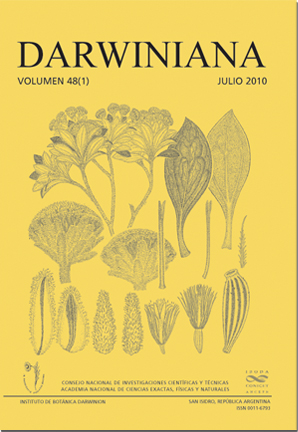Composition, structure and spatial pattern of Tucumano-Bolivia- no forest in the department of Tarija (Bolivia).
DOI:
https://doi.org/10.14522/darwiniana.2014.481.27Keywords:
Diversity, rarefaction, Ripleys K-función, spatial pattern, species composition, structure, Tucumano-Boliviano forestAbstract
The Tucumano-Boliviano forest, on its Bolivian side, has begun to be studied with greater detail in the last decade. However, the studies that have been conducted have had a more qualitative character or have been undertaken in small areas (0.1 ha); on the other hand, the biogeography of its lower zones is not completely understood. Moreover, some ecological aspects, such as tree spatial patterns, have never been addressed. We conducted a study in one hectare of tucumano-boliviano forest at 700-950 m, and mapped all trees and vines with DBH ≥10 cm in order to characterize quantitatively a representative area of this forest. The purpose was to obtain insight into its floristic composition, species abundance and structure. We carried out the first study on spatial patterns for this type of forest in Bolivia. We recorded 591 individuals belonging to 31 families, 47 genera, and 57 species. Six species were the most abundant and: Urera caracasana, Trichilia clausenii, Piper tucumanum, Diatenopteryx sorbifolia, Chrysophyllum gonocarpum and Cupania vernalis. The forest studied can be classed more as Tucumano-Boliviano forest than as a Pleistocene Arc type forest. Basal area was 29.04 m2/ha. There was a relatively scarce presence of lianas, which indicates that this is a relatively slightly disturbed community. This is a diverse forest. Species richness turned out to be comparable to that of Madidi dry forests, and greater than that in Tucumano-Boliviano forest in Argentina, and was estimated at 74 tree species. Diversity (3.5 Shannon-Wiener index) is as high as that in many tropical forests, even in Amazonia. We found a random spatial pattern in the individuals of the community, and most of the species exhibited clustering at some spatial scale.
Downloads
Published
31-07-2010
How to Cite
Zenteno-Ruiz, F. S., & López, R. P. (2010). Composition, structure and spatial pattern of Tucumano-Bolivia- no forest in the department of Tarija (Bolivia). Darwiniana, Nueva Serie, 48(1), 32–44. https://doi.org/10.14522/darwiniana.2014.481.27
Issue
Section
Ecology and Phytogeography
License

Starting on 2012, Darwiniana Nueva Serie uses Licencia Creative Commons Atribución-NoComercial 2.5 Argentina .






